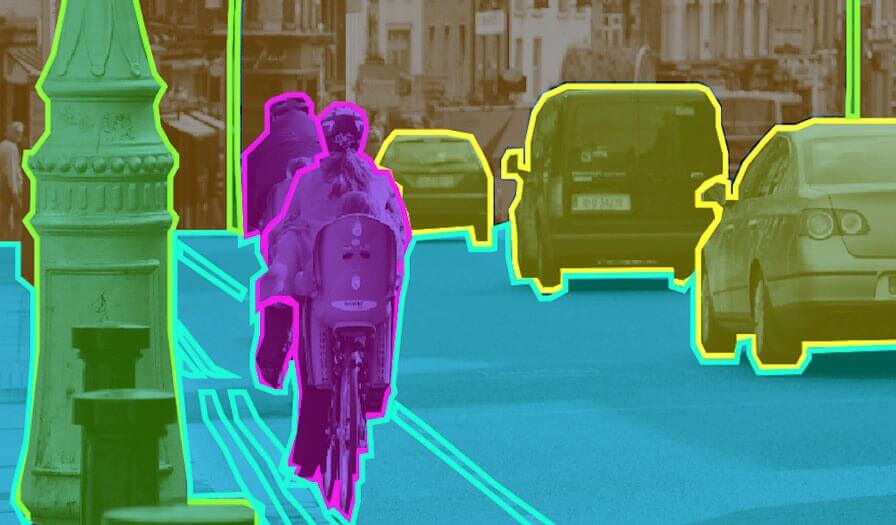
Image annotation is becoming the only technique that can provide the right visual perception to machines through computer vision algorithms. There are various techniques used for image annotation. Semantic segmentation is one of the most used techniques to create the training data for the deep neural network.
What is Semantic Segmentation?
It is the process of segmenting each pixel in an image within its region that has semantic value with a specific label. Semantic segmentation is a very authoritative technique for deep learning as it helps computer vision to easily analyze the images by assigning parts of the image semantic definitions.
However, semantic image segmentation is very much useful for deep learning that requires extra depth analysis of images while training through machine learning data. At the same time, it is also extremely difficult to carry out, as there are certain techniques that are used to create images with semantic segmentation.
Basically, it helps machines to detect and classify the objects in a single class, helping the visual perception model learn with better accuracy for right predictions, when used in real-life. So, right here we will discuss semantic segmentation types for image analysis in deep machine learning.
SEMANTIC SEGMENTATION TYPES
Region-Based Semantic Segmentation
Region-based semantic segmentation is mainly used for segmentation that incorporates region extraction and semantic-based classification. In this type of segmentation, first of all, only free-form regions are selected by the model and then these regions are transformed into predictions at a pixel level to make sure each pixel is visible to computer vision.
A specific type of framework is used to complete this in the regions through the CNN framework, or R-CNN, which uses a specific search algorithm to drag many possible section proposals from an image.
This runs through the CNN, dragging features from each one of these different areas. In the end, every region is classified using a linear support vector machine specific to the chosen classes in the same class providing detailed information about the subject.
The R-CNN extracts two different feature types for every region picked by the model. A frontal feature and a full region are selected. When these two region features are joined together, it results in the performance of the model getting improved with such segmentation.
Whereas, R-CNN models manage to utilize the discriminative CNN features and achieve improved classification performance, however, they are also limited when it comes to generating precise boundaries around the object affecting precision.
Drawbacks of Region-Based Semantic Segmentation:
- This feature is not compatible with the segmentation task.
- It doesn’t contain enough spatial information for precise boundary generation.
- Last but not the least, making segment-based proposals takes a long time affecting the final performance.
Fully Convolutional Network-Based Semantic Segmentation
CNN's are mainly used for computer vision to perform tasks like image classification, face recognition, identifying and classifying everyday objects, and image processing in robots and autonomous vehicles. It is also used for video analysis and classification, semantic parsing, automatic caption generation, search query retrieval, sentence classification, and much more.
Fully Conventional Network functions are created through a map that transforms pixels to pixels. However, different from R-CNN as discussed above, region proposals are not created. Fully conventional neural networks can be used to create labels for inputs for pre-defined sizes that happen because of fully connected layers being fixed in their inputs.
While FCNs can understand randomly sized images, and they work by running the inputs through alternating convolution and pooling layers, often the final result of the FCN is to predict the ones that are low in resolution resulting in relatively ambiguous object boundaries.
Weakly Supervised Semantic Segmentation
This is one of the most communally used semantic segmentation models that create many images with each segment pixel-wise. Hence, manual annotation of each of the masks is not only very time-consuming but also an expansive process.
Therefore, some weakly supervised methods have been proposed recently, that are dedicated to achieving semantic segmentation by utilizing annotated bounding boxes. However, there are different methods for using bounding boxes for supervised training of the network and making iterative improvements to the estimated positioning of the masks.
There are different methods for using bounding boxes. The technique of using the bounding boxes to supervise the training of the network and make iterative improvements to the estimated positioning of the masks. Depending on the bounding box data labeling tool the object is annotated while eliminating the noise and focusing the object with accuracy.
So, the most used method for semantic segmentation is used as an FCN, as it can also be implemented by taking a pre-trained network and with the flexibility to customize the various aspects as per the network fitting in your project requirements.
How to Prepare your Data for Semantic Segmentation Annotation?
Hence, to utilize the power of semantic image annotation, one needs to be prepared with a dataset that contains the classes in your dataset of roughly the same number of images. Here, the classifier will learn to distinguish the classes the best, if all the classes have approximately a similar weight to each of them.
If it is not possible, and the dataset itself has large discrepancies in its representation of classes, then while training the classifier the images should be graded to achieve more concordant representation.
If images are too blurry, then they should be removed from the dataset as they may confuse the classifier and make both image annotation and training of the CNN challenging. Hence, you need to consider if semantic segmentation is suitable for your machine learning project.
Depending on your use of the bounding boxes, semantic segmentation only distinguishes between regions with more meaningful segmentation but also distinguishes individual instances of an object. It can distinguish the different objects in a single class by separating them as different entities.
If you are looking to outsource semantic segmentation image annotation, you need to hire a professional and highly-experienced image annotation service provider that can annotate the images accurately with the best quality. Cogito is one of the well-known data labeling companies with expertise in image annotation to annotate images using semantic segmentation for AI and ML projects.
This post is originally published at click here



